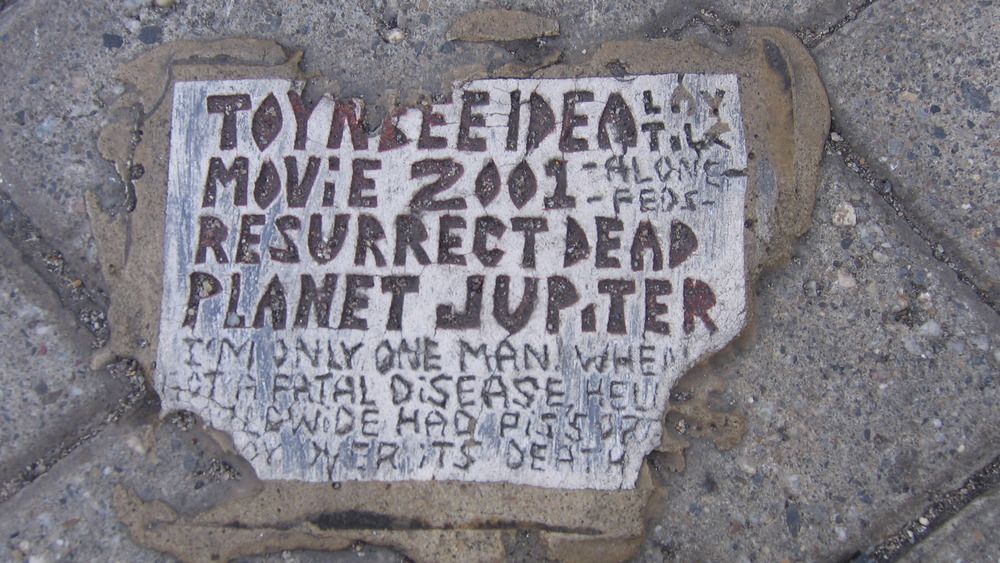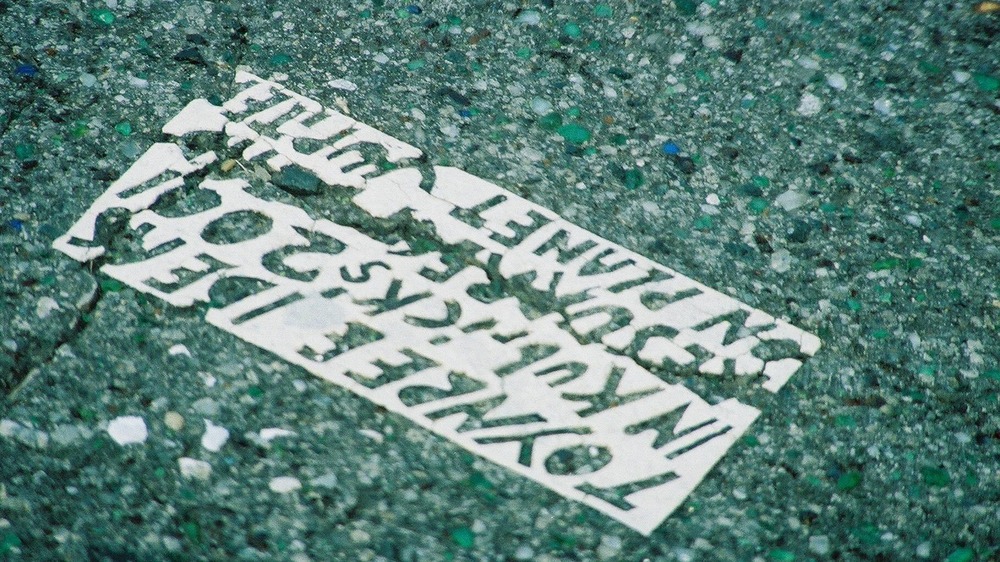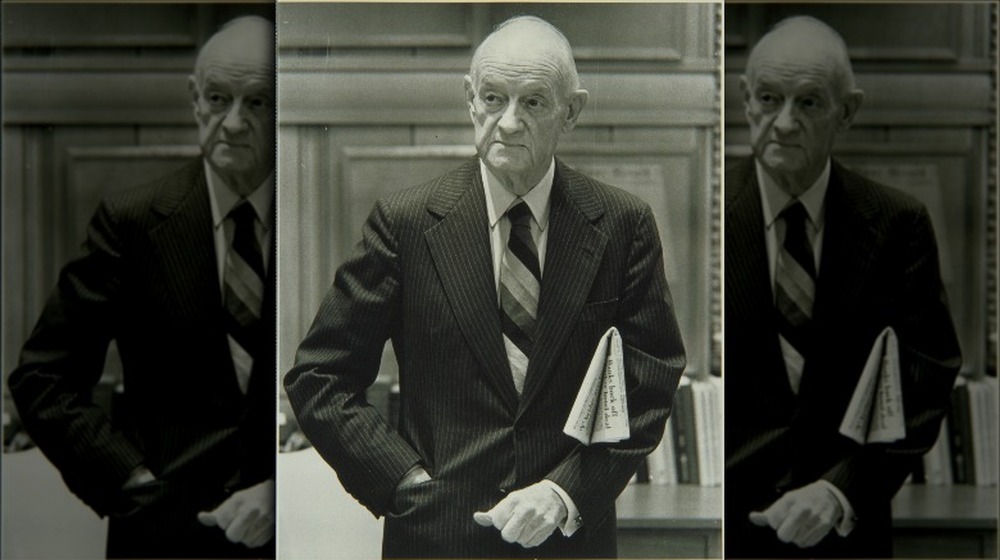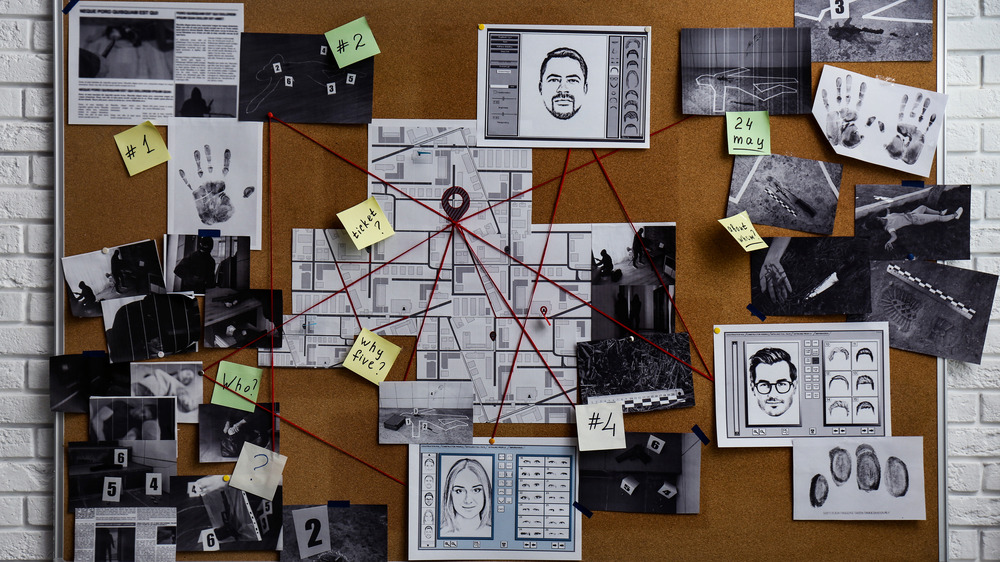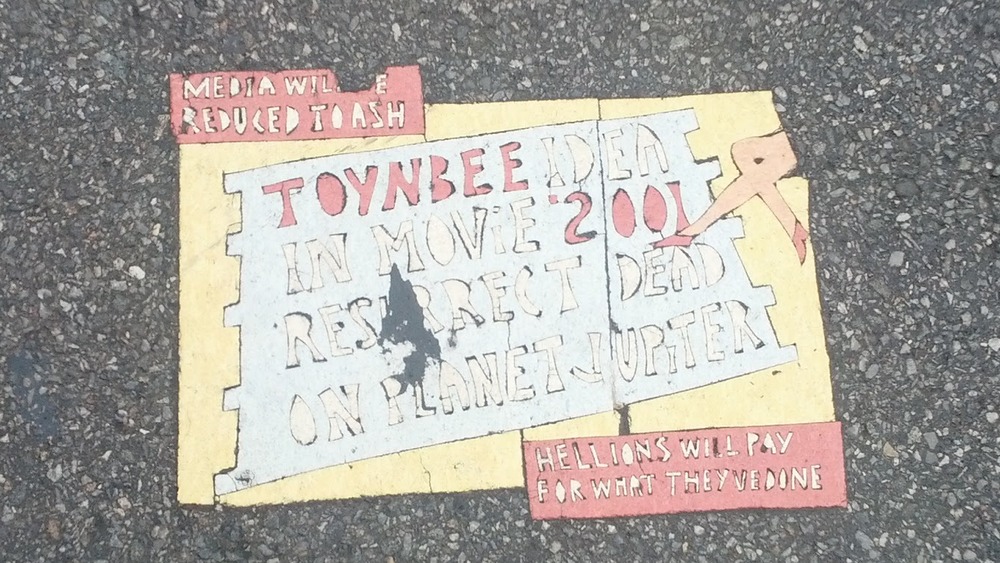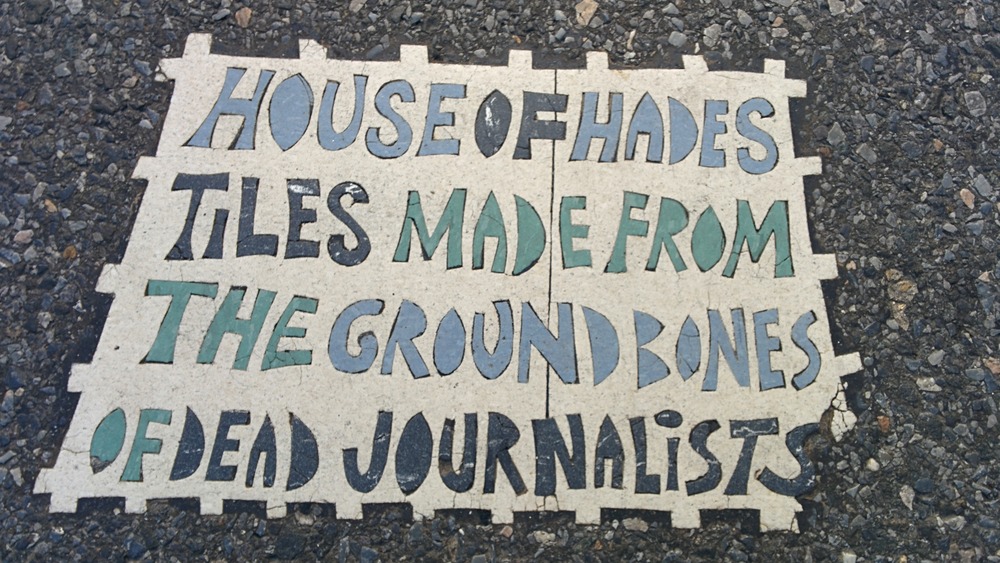What Are The Mysterious Toynbee Tiles? We Explain
Have you considered bringing the dead back to life? Possibly on a gas giant in our solar system? (Where else would there be room for all of the people who have ever died on Earth, right? Wouldn't not having elbow room on Mars or Venus be worse than death?)
No, no, hear us out now. There is this movie, 2001: A Space Odyssey, that explains the whole plan. Okay, not exactly in that movie. Maybe it was actually in a different story by Arthur C. Clark, who co-wrote the screen play for the film? Wait! It was actually from a historian. Yes, that was it. Didn't one talk about resurrecting the dead on the planet Jupiter?
Okay, fine. It wasn't an idea from a reputable historian or a movie. It was something from a cryptic linoleum tile embedded in roads throughout North and South America. Here is the story of the mysterious Toynbee tiles explained.
What is a Toynbee Tile?
Since the early 1980s, Toynbee tiles, usually about the size of a license plate, have been found embedded in pavement throughout the world (though most are within a two-hour drive of Philadelphia). According to the Kansas City Star, each letter on them is hand carved. These tiles, reportedly harder than the asphalt surrounding them, are impossible to remove without pulling up the pavement. The tiles tend to read something like "TOYNBEE IDEA / IN MOViE `2001 / RESURRECT DEAD / ON PLANET JUPITER." These cryptic messages reference life after death, based on both Stanley Kubrick's sci-fi movie and the philosophy of British historian Arthur Toynbee.
As director of public works, Doug Whitacre, told The Topeka Capital-Journal, "It is not for us to determine whether the tile is or is not art. Our crews have the responsibility to repair and maintain the integrity of Topeka's streets." This attitude is shared with most but not all tasked with the upkeep of roads. According to The Philadelphia Inquirer, the city's paving agreement says contractors must stop and inform a streets engineer when they find a Toynbee tile.
Justin Duerr, one of the filmmakers who created a 2011 Sundance Film Festival award-winning documentary about the tiles, Resurrect Dead, said to the Post-Gazette that he doesn't think the messages are about physical resurrection, but "Kubrick was definitely trying to say something ... about spiritual regeneration, and Arnold Toynbee talks about that a lot."
2001, like the movie?
Stanley Kubrick's 2001: A Space Odyssey, written by Arthur C. Clarke, is a weird movie. It involves a merciless AI and monkeys evolving by hitting a monolith. The protagonist Dave Bowman does end up as a space baby after entering a portal near Jupiter. There is no mention of Arnold Toynbee in that movie and, thus, no hint of his idea in there. However, Ray Bradbury did write a story called "The Toynbee Convector," which involves both Jupiter and reference to "a historian" named Toynbee. That seems a surer bet, though it is odd that the tile artist wouldn't have explicitly made that reference in the tiles since it is available.
That story involves a man named Stiles returning to the past with stories of how much humanity has achieved in 80 years, inspiring people to work toward this future. On this death bed, he confesses to making it all up. Despite this, the utopia he fabricated came to be. Still, the person hearing the confession decides to keep that to himself.
Clarke also has a story titled "Jupiter Five" (via Project Gutenberg), where scientists fly through space in a spaceship named Arnold Toynbee, so the tile artist would not be without more apt referents beyond 2001. As it involves space property rights, it may not have held much importance to the tiler, though.
Does the tiler believe that he is coaxing us toward a future of interplanetary immortality by leaving these messages embedded in public streets?
Who is Arthur Toynbee?
Arnold J. Toynbee was a British historian and philosopher who died in 1975, years before the first tile was laid (so this wasn't about goosing his own royalties). Though he had no lack of ideas in his years of writing, precisely zero of them involved literally resurrecting the human dead on any planet, let alone the gas giant of Jupiter. He was more concerned with keeping civilizations alive and parsing out the meaning of Jesus' resurrection.
He believed that a civilization's future is shaped by how its people perceive its history, forming the backbone of "The Toynbee Convector." If that is the case, could the tile artist instead be trying to make us more conspiracy-minded towards a more paranoid future? His message is far from cheerful at times. As Toynbee put it in Experiences, "Human nature presents human minds with a puzzle which they have not yet solved and may never succeed in solving, for all that we can tell." The tiler has certainly done that, though Toynbee meant this more in the sense of "the Christian terms of a psychosomatic resurrection than if he thought in the shamanistic terms of a disembodied spirit."
Experiences is not a light summer read.
4 AM
David Mamet, Pulitzer Prize-winning American playwright, based his 1983 one-act play, 4 AM, on radio host Larry King, who listens to a caller talking about Arnold Toynbee, 2001, and resurrecting life on Jupiter. The host then tries to systematically disassemble each of the illogical points.
Mystery solved! These tiles must be from the Mamet fandom, doing three decades' worth of viral marketing for his play. You know how fanatical those Mamet heads can be.
Unfortunately, no. Several pieces of evidence predate this play, most tellingly a call to the actual Larry King in 1980 and a 1983 article in The Philadelphia Inquirer (via The Kansas City Star) that Mamet likely reproduced in his play — though Mamet insisted to NPR that there was no call on the radio and that he made it up. In that same interview, he stated that he wrote the play because he listened to King on the radio in the middle of the night. It seems likely that Mamet's play is more an homage to the King call and Inquirer article than the tiles are an homage to his play.
All conspiracies turn to anti-Semitism eventually
In addition to messages referencing planetary resurrection, according to the Kansas City Star, the tile artist also despises journalists, specifically American newspaper publisher John S. Knight. The tiler labels Knight a "hellion Jew" and a Soviet spy who conspired with the Philly Mafia to attack him. The tiles sometimes have the message "Murder all journalists, I beg you!" — so not subtle on this particular point.
This bigotry and paranoia might be why the tiler has kept his message on the streets rather than broaching them in a way that could be tied back to him. He is already sure that he is being stalked by a cabal who would otherwise silence him. Why would he bother making himself a more prominent target?
The infamous and considerably larger Manifesto Tile, paved over in 1998, laid out in detail precisely what the tiler thought was going on. It includes that he fled the country in June of 1991 to escape Knight-Ridder's "great power to destroy" before they convinced the United States federal district attorney's office to get Interpol to find him in England.
What is known about the tiler
Most of the tiles were found in Philadelphia, so it is a safer bet that the tile artist lived there. Though many have tried since the first tile was laid down in the 80s, no one has definitively identified the tiler. While the tiles and their placement are public, no one has ever recorded or even seen him placing them. New tiles are still being discovered, though it is uncertain if these are the original tiler's work.
One can analyze that the tiler did not feel heard when he tried to broach his message in a call to Larry King or to Clark DeLeon of The Philadelphia Inquirer. Had the tiler started a decade later, he may have instead written an ironically enjoyed blog. He made no direct threats, so maybe making tiles alone scratched whatever paranoid itch he had. As Sgt. David Turner of Cincinnati told City Beat in 2001, "As far as we're concerned, there's no meaning for us, so we're not going to do anything about them."
The tile artist didn't want to make that message easily understood (or tile space was simply at a premium). It seems that he acted alone despite him telling DeLeon that his "Minority Association" consisted of "Me, Eric, Eric's sister who does the typing, Frank..." Colin Smith of Resurrect Dead told Atlas Obscura that, by the mid-90s, some tiles stated that there was only one tiler.
James Morasco
In 1983, a social worker named James Morasco called journalist Clark DeLeon at The Philadelphia Inquirer, pitching a story about resurrecting the dead on Jupiter and referencing 2001: A Space Odyssey. According to what the Resurrect Dead filmmakers told Film Journal, Morasco had formed a group called the Minority Association to help colonize this inhospitable planet. DeLeon laughed Morasco off, recalling to NPR, "It was just so wacky and out there. I believe my headline on it was, 'You wanna run that by me again?'"
A solid name. Yes, the city fits. But it is not the slam dunk that it might imply.
In 2003, a writer for The Kansas City Star called the number for the only James Morasco in Philadelphia. His wife answered, said that he knew nothing about the tiles and had died months earlier at the age of 88. He would have been in his 70s when most of the tiles were placed — not impossible, but unlikely. It likely discounts some of the more far-flung tiles being directly placed by him. However, WESA reported that Toynbee tile investigators discovered "test tiles" around his neighborhood.
Yet the tiles have persisted even into the 2020s, so it couldn't have been that James Morasco (or solely him). Was the charge taken up by Eric, Eric's sister who does the typing, or Frank?
Severino "Sevy" Verna
According to Temple News, the filmmakers behind Resurrect Dead suspected a man named Severino "Sevy" Verna. Unlike James Morasco, Verna is, for want of a better term, emphatically weird. He grew up in a funeral home and gained a reputation for collecting dead pigeons in buckets and covering them in concrete to preserve or resurrect them. While this method did not seem successful, it implies a fixation on the deceased. Filmmaker Justin Duerr said to The Post-Gazette, "We've never talked to the person who did them. We've had one-way communication, but haven't heard anything back from the person."
The filmmakers also claim that Verna had a car with a hole beneath the driver's seat, which would allow Verna to place the tiles on the street without getting out or being seen. WESA reported that Verna's neighbors confirmed this eccentricity of Verna's car.
Verna may have used the alias "James Morasco," which most could agree is an unlikely alias to have chosen at random for a man living in Philadelphia.
Verna is also not globe-trotting to place these tiles. City Beat reported that Verna lived at the address on the tile in Chile — though they assumed Verna was his first name and that he was a woman. Different publications seem to get contradictory stories from the same evidence but that fits the tiles' motif.
An address in Santiago de Chile
There is little in the hundreds of tiles that confirm who the tiler is (or was). It wasn't as though he would leave his home address on one. Except that he might have. According to ABC News, a tile in Chile reads, "Escriva: Toynbee A, 2624 S. 7th Street Phila, PA, 19148-4610, USA."
Another tile mystery solved! Let's knock on that door, shake the tiler's no doubt chapped hands, and ask for an interview.
Unfortunately, no. Other people have tried that, both physically and by phone. The residents of that home have said that they have no idea what a Toynbee tile is, that they are certainly not making them, and to please leave them alone. (Regrettably but unsurprisingly, curiosity seekers and reporters seem incapable of obliging them on this last point.) Some neighbors agree that the retiring introvert who lives there couldn't be the tiler — though this doesn't wholly discount that a previous occupant might have been.
So, why was there a tile that gave this address? It seems to be the tile artist (or a tile artist) reaching out for connection. Was the tile found too late, and he had already moved to avoid his persecutors? Had Knight-Ridder and Interpol already silenced him?
The shifting styles
According to filmmaker Justin Duerr, speaking to the Post-Gazette, the last original tile was likely placed in 2001 or 2002. Since then, all the Philadelphia tiles have been a dedicated copycat's work, to say nothing of those found in more far-flung locales.
In the 2000s, the tiles evolved from the simple message of resurrecting the dead to murals that would be next to impossible to place without others noticing (yet they were). The "handwriting" on them accordingly degraded. With so many more letters to cut and set just right, who wouldn't get fatigued? The tiles now tend to be far more deeply embedded in crosswalks and thus more difficult for the cities to remove. Some of the wording has inexplicably changed, such as substituting "raise" for "resurrect." When the message is only a few words long and is supposedly the whole point of the endeavor, why paraphrase?
Yet even these copycats have not been caught in the act of placing tiles, which is close to miraculous with increased electronic surveillance and recording devices in most people's pockets. As Gothamist notes, it is more believable that one person became excellent at placing tiles rather than that many people are just okay at it. How are they evading detection?
According to ABC News, Duerr admitted to creating and placing a tile as an experiment but swears that was the only time that he did it.
House of Hades
There is one definite copycat that even the casual investigator knows about because they sign most of their tiles "House of Hades." These tiles take a different tone — aside from talking about "the ground bones of journalists" — and seem to be an art project more than an attempt to convey the message about resurrection.
The Topeka Capital-Journal reported that one in Topeka, Kan., read, "HOUSE OF HADES/ONE MAN VERSUS/AMERiCAN MEDiA/IN SOCIETY' 2011/IT'S BEEN FUN!" Even that sounds too upbeat for the tile artist, for whom nothing seems to be fun.
According to the Post-Gazette, the House of Hades tiles also sometimes feature the shape of a woman's spread legs, which seems far too indecent for the original tiler. It distracts from the message about Arnold Toynbee and a Stanley Kubrick movie. However, Atlas Obscura also reported that House of Hades has made exact replicas of the original tiles without mentioning their tag, so perhaps they can forgiven for going obscenely off-book on occasion.
House of Hades has mailed tiles to others to install, making their exact location uncertain since those tiles appear more widely than the originals. Justin Duerr told The Philadelphia Inquirer that he suspected that House of Hades was based in upstate New York (and that these tiles are made of asbestos, so removal is further complicated).
"You must make + glue tiles!! You!!"
Some of the original Toynbee tiles give instructions on how one might create them. Toynbee tiles were meant to spread. The tiles' directions are vague, but it was enough to help people refine them into a workable recipe. It does not involve any special equipment or much time, unlike what Jeff Martin, supervisor of street maintenance for Kansas City, speculated to the Kansas City Star.
If you want to put your own tile on your driveway (and nowhere else!), here's how you do it. According to Atlas Obscura, first cut the letters out of linoleum and glue them with epoxy. Wrap this in roofing tar paper. This will protect the tile from being damaged or removed before it adheres to the asphalt. Cover the bottom with asphalt crack filler. The pressure of your car, combined with summer heat, will fuse the tile to the pavement and wear down the tar paper. This may take months or even years.
Even if the original tile artist has died, his message doesn't need to have died with him, though the world will never quite know what the tiles meant. Maybe perpetuating the tiles (and getting people talking about them) was the only real goal. If he has died, one can only hope to meet him on Jupiter to get the answers.
